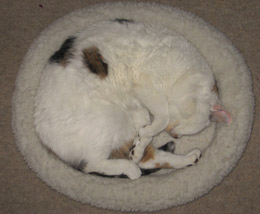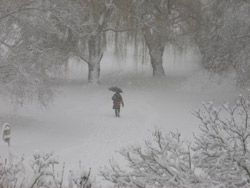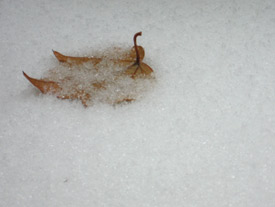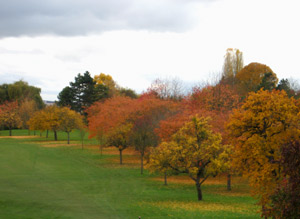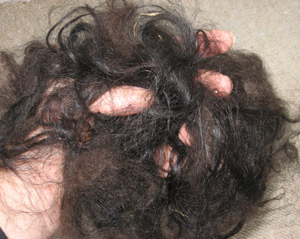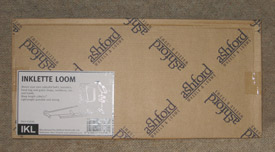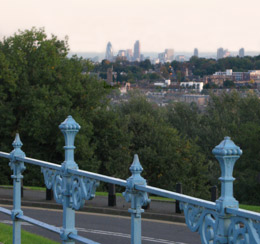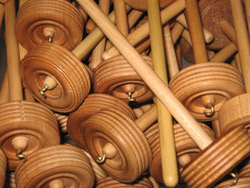The archives
Return to the
Archive directory
Return to the
Now spinning
page
Explorations, Autumn into Winter
October - December 2010
Isn't she just adorable???
Here in Hibernation Season, instead of spinning I've been herding cats. (Here it comes: more furry-friend talk. I'll try to be brief.)
When we decided to bring Big Guy in from the cold, we figured we'd let our existing adorable (and petite) cat get used to the idea that another cat might live in her space -- then gradually let them get to know each other. You know, the slow approach, to ensure domestic tranquillity.
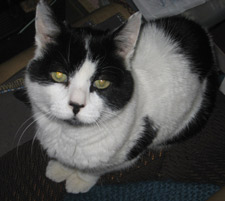
It was a good plan! During those first few days, while they were both grappling with the concept (but hadn't yet been less than two meters apart), we took Big Guy to the vet for a check-up (it's best to be safe). Well. The first thing the vet said, after feeling the cat's torso and giving it a listen, was, "I think he has a major heart problem." The second thing he said was, "He's severely anemic -- the skin in his eye sockets is white instead of pink! That could account for what sounded cardiac." Then he drew a blood sample and took it into the lab area. In ten minutes or so he came back and said, "Well, I'm sorry to say that this cat has AIDS."
More accurately, he tested positive for Feline Immunodeficiency Virus (FIV).
We came back home with some anti-biotics (the acute anemia was caused by bacteria attacking the red blood cells), and I went online to learn everything I could about FIV.
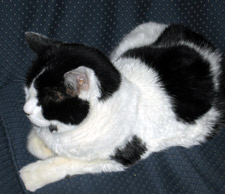
It's bad, but it's not as bad as human AIDS, and not quite as easily transmitted as human HIV. Most importantly, it's not a decree of imminent death. Big Guy will be vulnerable to any infection or cat illness that might be going around, but he can live a good life anyway. The symptoms of FIV itself (fever and discomfort) appear in the early days of the virus, and it looks as though his "early days" were quite a while back.
Meanwhile, there's the question of how contagious he might be -- because we don't want to put our Sleeping Beauty at risk. The world of veterinary medicine has mixed views about that. The usual way that one cat infects another is by "saliva-to-blood" contact, to wit: an infected cat bites another cat deeply enough so that FIV-bearing saliva can get into the bitten cat's bloodstream. Those deep bites usually happen when two cats are fighting over territory (I'm sure that's how Big Guy got it -- he was quite the Tom in his day!). ...But can the disease be transmitted by wet noses touching? By lick-marks in a shared food bowl? That's less certain.
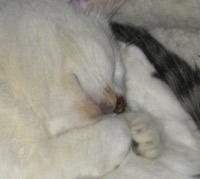
We're erring on the side of safety. They do everything separately: food, water, litterbox, sleeping area -- to each his own.
At first it looked as though Big Guy would be happy staying in his "bachelor pad", so they'd have totally separate spaces as well -- but as the anti-biotics did their magic, he got stronger, more and more alert, more interested in exploring other rooms.... Hey, he's an old guy. He's had a rough life. So how could I possibly deny him some pleasure??
Call me a softy. He gets to come out -- but only with supervision, always (hence, the "cat herding"). As you can see, as long as he's not crowding her space, the beautiful Ninette sleeps on, unconcerned.
As I type this, he's almost finished his 3-week course of anti-biotics. His coat, which used to be so dull and matted, is now sleek and glossy. He's still missing a bunch of teeth, but his hearing is getting better (!), and he actually prances when he walks. A miracle cat. Seeing this enormous change in him, it's almost certain that our bringing him indoors saved his life.
Purr, purr, purr.
End notes, for inquiring minds
♦ There's quite a bit of information online about FIV, including some that's very well-documented (I love references and footnotes!). For a good Wikipedia overview of the disease, its mechanisms and symptoms, click here. For a document about FIV from Cornell University, click here. For information on a more personal level, but full of information, read this woman's experience with her FIV-positive cat here.
♦ If you ever find yourself needing to give a strong-smelling pill to a cat and don't want to use the pry-his-mouth-open method, I have a word of advice for you: sardines. You have Big Guy's guarantee on that.
♦ Yes, of course I'm still working on that cat-and-silk scarf! It's wonderful in every way. Stay tuned....
The snow continues.
We're still staying warm indoors and sipping hot drinks while watching through the windows. It just seems like a good idea.
Much to the surprise of all of us, there's a cat story begging to be told. We didn't expect to have a cat story to share, but some things just insist on turning out a certain way, and here we are. ...For those of you who don't like cats, we'll keep the nuzzly parts to a minimum -- because I can assure you there's a yarn story coming right afterwards. ;-)
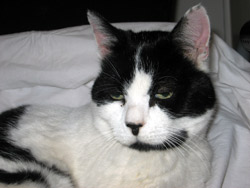
First, let's do the introductions: this (right) is Big Guy. He's not our cat. He has lived with a neighbour for 17+ years, and for almost all that time, he's been an Outdoor Cat (i.e., given food and water and a place to get out of the weather, but otherwise left on his own). Our neighbour got him as a young adult from someone else and says Big Guy might actually be as much as 20 years old (translation: if he were human, he'd be in his 90s).
Up until a few weeks ago, he had a cat companion; but she succumbed to cancer and left him on his own.
We worried about Big Guy, all alone without his friend. We stopped by his shelter to say hello more often than usual -- and noticed that he looked (and smelled) like a guy who'd been sleeping under bridges. So we started grooming him. He loved it! ...He also really needed it. There were sticky bits, and matted zones, and lots and lots and lots of hair! It had clearly been a very long time since he'd groomed himself, for any of the following reasons: (a) his back is stiff, (b) he's missing several teeth, (c) he wanted to make a cat fashion statement, or (d) all the above.
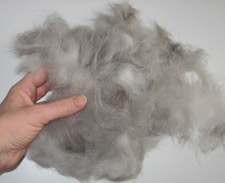
For the first several brushing sessions, we got huge piles of cat hair (left). It was amazing that so much hair could come in a single brushing, from a single creature! We brushed for more than an hour on Sunday, then again on Monday. Each time we thought we'd brush out less hair than before -- and each time we ended up with just as much.
(If you've been waiting for the "yarn" part of the story, here it comes.) We got masses and masses of cat down. Masses. How could a self-respecting handspinner just throw it away??? The universe delivered an unexpected wealth of downy hair... and discarding it seemed ungrateful.
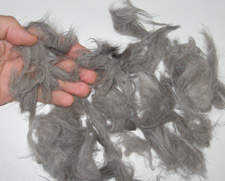
The first step, of course, was to wash it. (Let's not dwell on all the reasons why, okay?) I put some gentle, not-too-sudsy detergent in a washbasin and filled it with warm water, then submerged the cat hair in it. What came out (right) might not look very nice -- but it's still soft, and (most importantly) it's clean!
In my eagerness to see how the hair would wash up, I just plopped the handfuls of fibre into the water -- where they dispersed themselves beautifully and were hard to fish out afterwards! Next time I'll remember to put them in netting (either in a bag or simply folded in a piece of net).
The clumpiness you see in the photo is quite temporary, by the way. With any kind of handling, the fibres separate nicely -- and they now have less static electricity than they had before washing.
From the moment the first brushful of Big Guy hair got pulled from the slicker brush, I knew what I wanted to do with it: blend it with silk! And so I did:
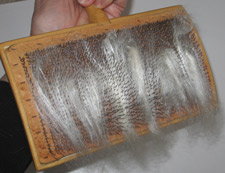
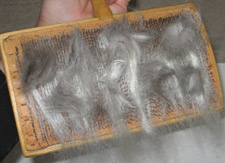
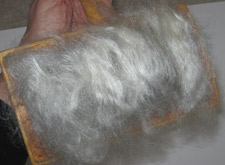
I blended the fibres with hand cards. First, I dressed a card with a layer of silk (far left), then a layer of evenly-spaced cat-hair clumps (centre), then a final layer of silk (right). I gently carded the fibres together, once, twice, three times -- figuring that since there was a radical difference in length between the two fibres, it would be a really good idea to have them nicely blended.
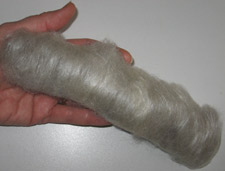
The resulting rolag (left) was spectacular, if I do say so myself. ;-) It had a tempting sheen, but a warm promise of fuzz as well -- making me dream of a lightweight, warm yarn with both shimmer and a lovely downy halo.... Looking at that rolag, you'd never guess it was almost half cat brushings! (Click on the thumbnail to see a bigger picture.)
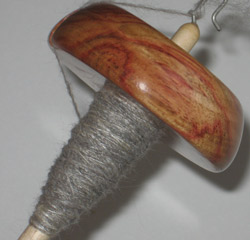
And my, my, my, it spins into a yarn that I like very much!
This photo (right) shows a singles-in-progress on the spindle -- in fact, what you see there is one rolag's worth. Much to my delight, it was nice to spin! I'd worried there would be extra static electricity, or cat hairs escaping to stick to me instead of to the other fibres -- but my worries were unfounded. It was just nice!
To spin it, I used a firmly-controlled short draw and plenty of twist. Controlling the drafting zone was essential: a less-controlled or longer drafting zone allowed the cat-hair part of the blend to separate from the silk -- not the desired effect! The high twist was essential as well: both silk and cat hair are smooth fibres, relying on twist to hold the yarn together.
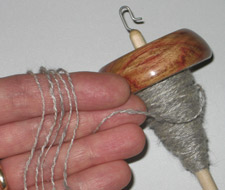
The firm twist also makes it easy to ply into a pleasant little yarn (left). Because the blend is based on silk, it's more forgiving than a similar blend featuring wool -- here, there's no need to worry about balancing the twist. Give the yarn what it needs, so it's the way you want to see it -- then when you're done, give it a rinse, and all will be well. (I love spinning with silk. It rewards you at every turn.)
You can clearly see the contribution each fibre makes to the yarn. The silk provides stability and a subtle gleam; the cat hair's downy nature shows in occasional airy "puffs".
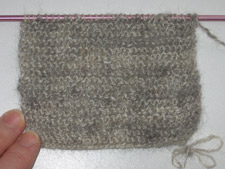
This cat-silk blend is useful, too! This simple garter-stitch swatch (right) has convinced me to spin more of it -- it's a lovely thing, whisper-weight, with both shimmer and warmth. It's hard to imagine how a yarn could make better use of the best traits of each of these fibres! (For a larger-than-life detail view, click here.)
I think it will make a beautiful lace-weight scarf.
For me. And for Big Guy.
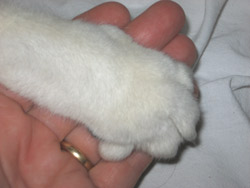
End notes, for inquiring minds
♦ The spindle used to spin this amazing fibre blend has a Tulipwood whorl and was made by Jonathan Bosworth. (Thank you, my friend.) Click here to see his spindles, wheels, and other spinning delights.
♦ The silk fibre used in this blend was tussah silk top, undyed. Other smooth and shiny silks would work, too; but the creamy presence of the tussah looked nicest with the grey cat hair.
The seasons have changed. How extraordinary!
The snow arrived in France about the same time I returned. The first wave came in flurries of small flakes, dancing through the air and making mini-drifts on every surface. The next day warmed, and while the snow stayed on, it solidified, became heavier, with translucent crystals that caught any afternoon light and amplified it for our pleasure. Occasional snowfall over the next few days kept the grassy areas from returning to their normal green -- then this morning's heavy swirls of generous flakes brought us back to the start.
It's nice and warm in the apartment. :-)
There's a fine sense of luxury that settles in when you can be warm and comfortable and snug in your favourite chair as you contemplate a sub-freezing scene outside.
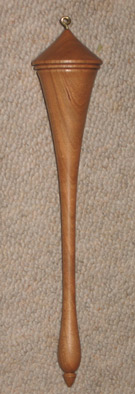
I have a friend who thinks of me sometimes and sends me the most amazing surprises. This beautiful, beautiful spindle (left) was nestled in the surprise package that I found here on my return home. I think it's one of the most elegant spindles I've ever seen.
And what better way to greet the winter weather?? With a bit of lilac silk in one hand and the spindle in the other, I set to work.
It's fascinating how tools train us as we use them. In this case, it was a matter of learning to trust the spindle, which isn't how I started out with it. ...I'd seen pictures of spindles like this before -- on the Internet, in Bette Hochberg's book Handspindles, and probably in magazines -- but I'd never met one "in person". In my imagination, this had always looked like a slow spindle that would spin for just a while, then stop.
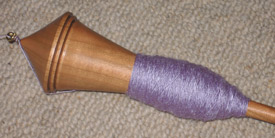
My imagination was wrong. It's a wonderful spindle! Its shape gives it fine stability, and it spins quickly... and for a long time.
Beyond its behaviour, it's an absolute pleasure to use. The wood feels like satin. The turnings on the end of the spindle shaft are a delight to my fingers each time I wind on more yarn. Whenever I set the spindle down, I can't help but admire its sleek lines -- so simple, but so lovely. It's just... perfect!
Winter will be grand. :-)
Thank you, my friend.
01 December 2010
Sunrise - Sunset - Sunrise - Sunset
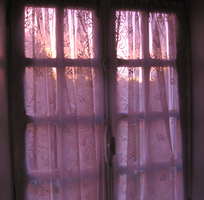
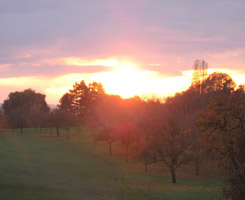

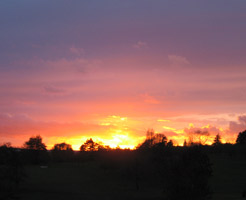
November passed in a series of sunrises and sunsets, swiftly flowing from days to weeks.
The month began with me in Dublin, virus-y but full of ideas from Ireland's Knitting & Stitching show. At November's end, I was shivering in the snow of northern England, tired but inspired by the final Knitting & Stitching show of the season.
Home again, the suitcase isn't yet unpacked -- but as usual I'm marvelling at how a whole month can pass so quickly when you've filled it to the max! On the month's calendar only a few days had writing in their spaces; but November was very, very busy all the same. If you've ever prepared a stand as an exhibitor in a show, you'll understand; but most of my friends here haven't, and don't....
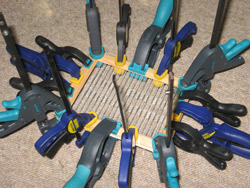
Virus notwithstanding, lots of things leap in to fill those calendar days that might appear "free". The living room is suddenly inhabited by strange creatures (left) that scratch and scrabble their way from glue pot to vibrating sander, then bask for hours in a sheltered spot where the oil can soak into their frames, leaving them shimmering and smooth.
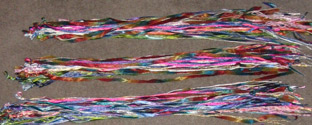
Meanwhile, on the other side of the room, large cones of yarn vie for attention, each tumbling over the other in eagerness as I wind warps for braiding kits: ribbons and sparklies, matte yarns with deep colour, variegated rich hues mingling with subtle bass notes -- a cascade of pleasure.
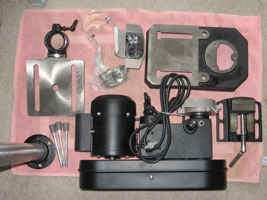
There are heddles and silk packets, spindles and braiding kits, tablet-weaving warps, booklets, samples, labels, and instruction sheets -- and as each item makes its way into the suitcase and gets crossed off my List, my imagination reaches forward to the period that will follow the show....
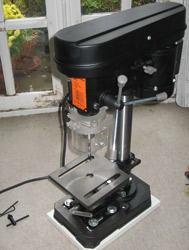
Now that the last show is over, we enter a new phase -- and here's something new to help us along. Starting from well-oiled parts (left), this machine was built in a stolen moment in late November. Despite the written instructions (why do they feel they need to give each bolt a name?), assembly was easy; and it not only runs just fine, it runs silently. This is good in oh, so many ways!
It's a drillpress, known here in France as a "drill on a column". Like all my tools, it lives in our living room. (My husband is a patient man.) You'll be seeing the fruits of its excellent work in the weeks to come. Stay tuned, because I'm going to keep you in suspense until I can show you a nice collection of the New Things!
Sunrise, sunset.
The world keeps moving. As do we. :-)
It's autumn. Everything's changing. It's beautiful.
This photo was taken a couple of days ago, just before the winds brought in hard lashes of rain and stripped the trees of their colour.
Here, though, you can still see them in their glory: despite the grey sky, there's light shining in the tree branches, and pools of orange and gold lap at the foot of each dark trunk. The gloom of the day shows in the blurring of detail: full-sized, this image looks more like a painting than a photo. Impressionist gloom, with bright leaves.
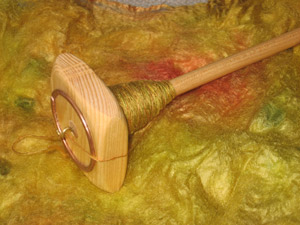
Autumn is a shape-shifter.
We greet autumn nervously, with conjuring tricks.
Here is an excellent trick (right): Spin shining silk in autumnal colours, and the day will be brighter, the light will last longer, the sunny yellows in your hands will protect against the wind that shakes your door.
Was it conjuring that led me to pick up these silk hankies? I think maybe it was. ...They came home with me from Dublin, gleaming in the depths of my suitcase, waiting, saving their magic for the day when it would be needed.
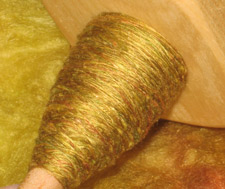
I'm spinning them fine, to make the silk last -- to make the daylight last. Holding the pile of hankies gently like an oracle, I peel each layer of hankie off the stack, so fine that I can barely see it. I coax one corner into an even finer layer, a gossamer presence not entirely visible, whispering of mulberry leaves long since gone, a whisper audible only because I'm listening.
I feed the whisper of silk to the twist.
Layer by layer. Twist by twist.
The rain glues frightened leaves to my window.
Here inside, sheltered by a fine spell of silk and twist, I'm safe.
End notes, for inquiring minds
♦ These beautifully dyed silk hankies were produced by Jean Oliver, a master dyer living in the north of England. She has no website, but you can click here for contact information and descriptions of her work.
♦ The spindle in these photos is... no, wait. I won't say more about it just now. Stay tuned, though, because you'll hear more about this spindle very soon!
I'm back from Dublin and once again immersed in my virus. Halfway through the show it started tiptoeing back, stealing my voice and sending me rummaging for tissues (more accurately, it sent me "rubbajig").
Home again, staying indoors with tea and tissues -- what better time to plunge into a fibre adventure???
This mass of dark fibre (left) is a freshly-washed handful of Icelandic fleece. I bought it long enough ago that it's well-aged (and smells a bit over-ripe when you open the bag!), but not so long ago that its oils could stiffen and get unpleasant. Once washed, it's lovely: amazingly soft, with a pronounced sheen on the deep-toned long fibres and a delicious warmth from the soft, short ones.
This fleece came from a young sheep, and it's finer overall than many Icelandic fleeces. It's also much darker than most fleeces I've seen: a near-pure black in the grease, it lightens only slightly in washing.
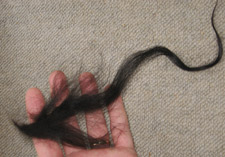
Icelandic sheep are dual-coated, meaning they have a two-layer fleece, as you can see in this photo (right) showing a single lock pulled from the mass. The long fibres serve as a sort of "outerwear" for the animal, helping wick rainwater and snow away to keep the sheep's skin dry. The short fibres are a sort of insulating "underwear", trapping warm air next to the skin in even the harshest weather.
The difference between these two layers is easy to see, and there's usually a pronounced difference in their feel as well. The long fibres, known as tog in Icelandic, are fairly coarse and hair-like. The short fibres, known as thel, are very fine and warm, much like cashmere or camel down.
Traditionally, the two layers were separated and used for different purposes, with the tog being spun for warp yarns, rugs, and strong cord, and the thel being reserved for warm, next-to-the-skin garments. Many Icelandic fleeces still warrant this treatment, and benefit from it.
This fleece, however, is so delicious in the hand that I didn't want to change anything! It's very fine. If you look closely at the photograph of the lock, you'll see that beyond their lengths, there's little visible difference in thickness between the tog and thel. There's a difference in sheen (and a slight difference in colour), and the fibre structures are different -- but they're both quite fine.
I decided to spin them together.
A fuzzy head puts me in a funny mood: I took a nice handful of fleece, teased it open, and spindle-spun it directly from the teased mass -- just to see how it would work. It made a nice yarn! ...I plied it. It was still a nice yarn, though maybe just a touch stiff (not quite wiry, but almost). ...So I decided to wash my sample skein and let it dry... and darned if it didn't turn out to be absolutely wonderful!
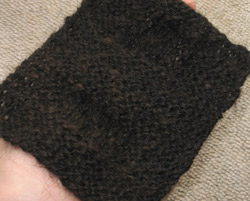
Unwilling to just let it go at that, I knit up a little swatch. This photo (left) has been brightened up a bit so you can see the detail -- in real life, it's such a very dark wool that you need to hold it under bright light to see the variations in the yarn.
But here you can see the thing that makes this swatch so wonderful: the deep tog fibres shine through with a nice sheen, while the thel, appearing here and there in patches, spreads its warmth through the knit stitches like a friendly cloud.
It's magical. I want to wear it. I want to make a nice sweater-jacket from this fleece, then wrap it around me for winter after winter after winter!
Pretty yarns weren't the only thing to follow me home from the Handweavers Studio. :-)
At Convergence in Denver (when was that? 2004??), the amazing Robyn Spady brought along a tiny inkle loom that she'd made. It was a beautiful thing made of exotic woods -- a prototype, she said. It peeked out of her rolling trolley with gleaming little pegs and perfect charm. I wanted one.
In the end Robyn never put them into production herself, but she worked closely with the Ashford team in New Zealand to help them design, refine, and introduce their own little loom, the Inklette. The final result: it's cute! I've looked and yearned. I've dreamed. And then suddenly there I was in the Handweavers Studio, in a weakened condition with some money in my pocket....
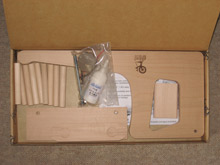
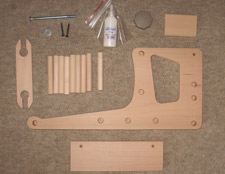
Back at home, I contemplated the box. It was discreet, but promising.
Lifting the box's lid gives you the impression you've been given everything needed to put the loom together (even sandpaper and glue!).
When you pull everything out of the box, that impression is confirmed.
This has got to be one of the easiest kits I've ever put together! All the pieces fit together nicely, and there was no confusion about what piece should go where -- it all just worked. To please my own personal tastes, I did a little more smooth-sanding than was absolutely necessary -- but my tastes are pleased and happy, and I like the result.
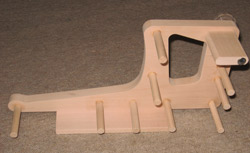
Here it is (left), all put together, with its glue dry, but its wood still bare and unfinished. I admit, it was very hard to wait for everything to be dry and done -- I wanted to use it right away!
Part of my impatience is that I'm still slowed a bit by this virus -- it returned to haunt me like a nagging worry in the wake of the show in London. Being slightly under the weather makes me want to do something fun. Something that doesn't involve blowing the nose or coughing.
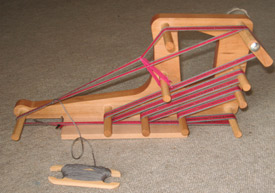
So, of course, I finished the wood nicely, just for the pleasure of it (my personal tastes were ecstatic about that). And then I warped it.
By the way, this is a cautionary tale: I followed the printed instructions for warping and am now sorry I did. See the little tensioning flap at the upper right corner of the loom? In this photo, it's in the position the instructions recommended -- and I can tell already that it won't give me enough "slack" to accommodate the take-up as I weave this warp off.
My tried-and-true inkle loom (built with Dad, following plans in Helene Bress' excellent book Inkle Weaving) has a sliding-post tensioner, and that has always worked beautifully.
This is my first experience using a loom with a flap tensioner, and as I look at it (after weaving just the first few inches), I'm wondering if its flap is big enough to adjust tension for the full length of its warp. That is -- I'm wondering, and I'm skeptical. :-/ ...We'll see. The proof is always in the weaving.
It sure is cute, though!
Meanwhile, I'm supposed to be getting ready for the next Knitting & Stitching show -- in Dublin! So now I'll set my weaving projects aside and launch into the work at hand....
End notes, for inquiring minds
♦ Whether you like flap-tensioned inkle looms or not, you can read more about the Inklette on the Ashford website, which you can see here.
♦ The amazing Robyn Spady went on from her inkle explorations to investigate ways of weaving beautifully complex galons and trims. She's documented it in an excellent monograph, available here. You can also check out her blog here.
19 October 2010
Around London, after the show
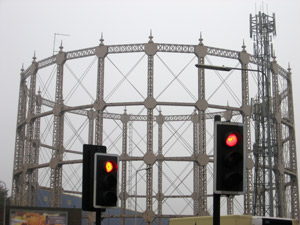
A visit to London wouldn't be complete without a brush with history. This interesting structure (left) is a vestige of earlier times, when homes were illuminated by the soft glow of gaslights, and lamplighters roamed the streets at dusk and at dawn.
The soft gaslight of those earlier times was not the natural gas we know and use today -- it was town gas, also known as coal gas, a manufactured gas widely used from the early 19th century until just after World War II (in some areas it was still being used into the 1970s). Structures like this one were built to store the gas, and as they served only the neighbourhoods close by, their distinctive shapes dotted urban landscapes throughout the UK and continental Europe.
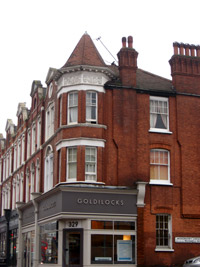 The structure is called a gasometer. A telescoping cylindrical structure inside the framework held the gas and kept it at good pressure so the customers nearby would have gas on demand, nearly instantly.
The structure is called a gasometer. A telescoping cylindrical structure inside the framework held the gas and kept it at good pressure so the customers nearby would have gas on demand, nearly instantly.
This gasometer, with its finials and delicate reinforcements, was rather elegant. It was a striking landmark on our daily morning drive to Ally Pally. Another gasometer on the opposite side of the hill was plainer -- no finials and much more rust. Echoes of the past, looming mysteriously in our daily lives.
Also along our road, a landmark of a totally different kind caught my eye more than once (right). I offer it here just in case anyone besides me wondered what ever happened to her. Looks like she's done all right. ;-)
After the show at Alexandra Palace, my cohorts and I wanted to do something special to celebrate having survived the show in reasonable shape. We decided to visit the well-known Handweavers Studio.
None of us had been there before. We were in for a real treat!
The Handweavers Studio is something of a legend in the UK. Founded I-don't-know-how-long ago as a shop catering specifically to weavers and handspinners, Handweavers Studio has remained true to its charter. I'd heard of it years and years ago, and for a long time had hoped to stop in at its location on Haroldstone Road -- but never got there.
About a year ago, the Handweavers Studio changed hands -- and locations! Now situated on Seven Sisters Road, the shop has been reborn. It has a fresh storefront that's easy to find, it holds true to its mission as a source and resource for handweavers and spinners, and to our delight as we stepped inside, it's comfortable and absolutely beautiful.
We were warmly welcomed by Wendy, the shop's new owner, and as each new wonder unveiled itself, we exclaimed, drifted apart, gathered wonderful things into shopping baskets, dreamed nice dreams....
Some shops are simply shops. Others are places that spark the imagination, nurture ideas, connect vague thoughts and reshape them into project plans -- and then provide whatever you might need to accomplish those plans. The Handweavers Studio is definitely one of the latter!
I was so impressed and happy that I forgot to dig my camera out of the car, so we'll have to give you verbal pictures. Imagine floor-to-ceiling shelves filled with silk yarn in every imaginable colour, beautifully lit so the sheen takes your breath away. Imagine another, similar set of shelves filled with a rainbow of mercerized cotton, so lustrous you need to touch the yarn to believe it's really cotton.
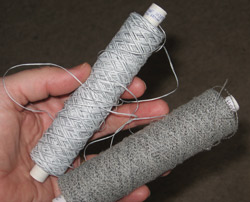 Imagine a tall shelf full of small, interesting bins, each containing little cops of yarn in the most amazing varieties: super-twisted cottons for collapse weaves, paper yarns, yarns of stainless steel and wool, jelly yarns, glow-in-the-dark yarns, yarns with little noily neps and a beautiful hand, yarns of impossibly fine linen....
Imagine a tall shelf full of small, interesting bins, each containing little cops of yarn in the most amazing varieties: super-twisted cottons for collapse weaves, paper yarns, yarns of stainless steel and wool, jelly yarns, glow-in-the-dark yarns, yarns with little noily neps and a beautiful hand, yarns of impossibly fine linen....
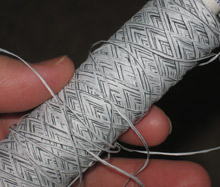
Some of these amazing yarns followed me home (of course!). Two in particular are just stunning, speaking as a handspinner. First, take a look at this one (right). It's labelled as "viscose sized rayon", and it appears to be three fine strands (one of them black) very loosely plied. While it looks as though the strands would separate when handled, they don't -- the sizing keeps them firmly attached to each other. (Or that's how it seems to me, anyway.) It's a lightweight yarn with a perky crispness and spring, like a fine linen, but only a fraction as dense.
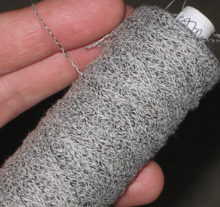
The second amazing yarn (left) takes my breath away and makes me want to duplicate it! Click on the thumbnail for a close view -- it's really worth it. The yarn is made of cotton and horsehair.
Structurally, it's magnificent. The horsehair at the heart of the yarn is plied (Z twist) with a fine cotton singles. Because horsehair is stiff and cotton is not, the cotton yarn effectively spirals around the horsehair. ...This 2-ply yarn is then plied (S twist) with another fine cotton singles. Again, the fine cotton spirals around the original structure, this time in the opposite direction. ...Finally, the 3-ply yarn is plied (Z twist) with a final fine cotton singles. The resulting effect is that of an enchanting, delicate white lace chain dancing around a firm, dark core.
I don't know what I'll do with it besides gaze in admiration. It's an object of beauty just as it is, but it would be wonderful to show it off somehow.
It was an amazing day. That one, inspiring visit to Handweavers Studio shines the brightest light over all the time we spent in London. Just plain wonderful. :-)
End notes, for inquiring minds
♦ The Handweavers Studio is worth a visit if you're anywhere near London, and their catalogue is worth perusing even if you're not. Click here for the full scoop.
♦ Gasometers have nothing to do with yarn or fibre, but they're darned interesting! To read more about them and their uses, check out this article in Wikipedia on Town Gas.
Alexandra Palace. Known to its friends as "Ally Pally", it's unlike any other show venue.
The palace was built on top of a hill, and its vista is still completely unencumbered. When the weather's just right you can catch a fine view of downtown London over its railings (left). That sunset view offers a breath of Zen at the end of a very busy day....
Of the three annual Knitting & Stitching shows, the one at Alexandra Palace is by far the largest. People come from all over Europe just to attend the show, and the event's organizers claim to welcome more than 55,000 visitors each year.
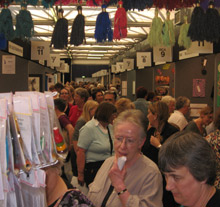
Going by what we could see from our Braidmakers' Workshop booth, those claims are valid! This photo (right) was taken during a "lull", believe it or not. It looks out the front of our booth down the aisle leading to our little corner.
We met visitors from all over: from England, Scotland, Wales, and Ireland, as one might expect; but also from North America, Sweden, Denmark, Finland, Holland, Belgium, Germany, Italy, France, Spain, Portugal and Russia. That's an impressive turnout for a show that modestly calls itself "Knitting & Stitching"!
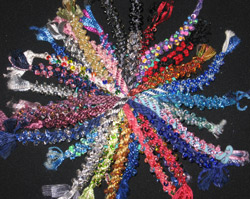
What makes the London show so special? Its setting plays a role to be sure -- but another factor is its size. It is a big show. As the largest Knitting & Stitching show, it hosts more exhibitions than any of the other shows, and it offers more classes. There are, of course, more vendors, many of whom come to just this one show and work in their regular shops the rest of the year. And... there's something energizing about being part of a huge gathering of people, all of whom are there because they want to be, all of whom are knitters or stitchers or weavers or embellishers, all of them eagerly seeking dazzle and inspiration.
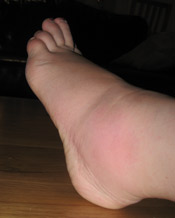
That eagerness and enthusiasm comes through above and beyond all else. Because of the crowds, a number of visitors found themselves trapped in front of my table -- and we had some fine conversations. I chatted with an archaeologist about weaving with a warp-weighted loom, gave an extended braiding lesson in French, learned some fascinating things about clothing structure from a Tudor re-enactor, and got to admire (and touch!) an absolutely stunning braided-beaded necklace (all semi-precious stones in shades of coral and red).
We arrived at the show carrying our boxes in with bold strides -- we hobbled home afterwards on puffy feet (that ankle on the right, by the way, is usually quite boney!). But it was worth it. It always is.
Will we do it again next year? ...If we're all still able to trundle along on our own two feet -- yes!!
Aren't they beautiful???
We're in the week before the Knitting & Stitching Show at Alexandra Palace (London), and I'm in full manufacturing mode. These spindles aren't actually for the London show -- rather, they're the full collection of spindles for the season's spinning classes. In the past I've made separate batches of the spindles needed for the classes at each show; but this time around it seemed like a nice idea to just go ahead and make them all at once. ...I've got to say that having a box full of spindles, all balanced and ready to go, feels just wonderful!
I'll bet real manufacturers never get to feel this rush of pleasure and satisfaction.
Those who check in here regularly will be used to my sporadic silences -- but I'll be popping in with news between shows, because some things are just too good not to share! Stay tuned....
End notes, for inquiring minds
♦ The Knitting and Stitching Shows are four-day events held each year in London, Dublin and Harrogate. The setting for the show in London is the incomparable Alexandra Palace. It's the largest textile-related show in Europe. Click here for dates, prices, class descriptions and more.
♦ My spinning classes (with silk, of course!) are scheduled for the Knitting & Stitching shows in Dublin and Harrogate. Click the link above for details.
Return to the Archive directory page
Return to the Now spinning page
